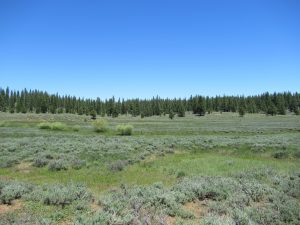By Deidre Monroe, Intern
Next to Dry Creek in Russel Valley, just north of the town of Truckee, lies a meadow that may appear beautiful, but is disconnected from its floodplain.
Where water once spread out across the meadow surface, channels are now incised due to 150 years of logging, grazing, and development. This causes erosion and increases sediment flowing into the creek, which eventually ends up in the Truckee River, degrading both water quality and habitat.
When a meadow is dried out like this, sagebrush replaces grasses, sedges, and willows. And with less absorbency there’s a greater threat of drought, wildfire, and flooding. That’s why the benefits of the Dry Creek Restoration Project, led by Beth Christman, are multi-faceted – encompassing wildlife habitat improvement, fire hazard prevention, and forest health in addition to water quality improvement.

Photo by Beth Christman, Project Manager for Dry Creek Meadow Restoration
In 2012, The Truckee River Watershed Council (TRWC) completed a watershed assessment of the area with the U.S. Forest Service (USFS). Parts of the meadow were restored in 2015, but there is still work to do.
This September, TRWC, the USFS, and others will complete the last phase in restoration:
- Restoring 30 acres of meadow and 700 ft. of stream
- Restoring floodplain function
- Improving water quality
- Improving resilience to climate change
Read more about this project in our Summer Newsletter.
Thank you to the funders who are making this work possible – the donors of the Truckee River Watershed Council, California Department of Fish and Wildlife, Lahontan Regional Water Quality Control Board, National Fish and Wildlife Foundation, and the Truckee River Fund of the Community Foundation of Western Nevada.
